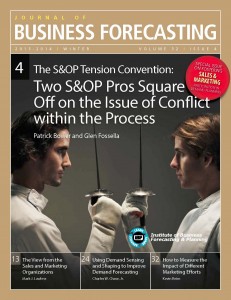In any organization, two functions that play a key role in generating business are Sales and Marketing, neither of which can do it alone. They need each other’s support, as well as that of Operations. Since each function has different roles and responsibilities and are evaluated on different sets of metrics, their agendas don’t align, which become a source of tension. The key concern of Sales is selling, the metric on which it is evaluated; Marketing, increasing market share, and brand building; and Operations is responsible for improving production efficiency and providing optimal customer service with minimum inventory.
The theme of this special issue of the IBF’s Journal of Business Forecasting (JBF) is to investigate the sources of tension across these functions, and what can be done to create harmony. We asked various practitioners to share with us their experiences. Patrick Bower and Glen Fossella believe that tension is healthy as long as it is managed, because many new ideas result from opposing views. In their experience, tension arises from using different and conflicting metrics, unrealistic expectations, lack of information sharing, and not understanding the language of others. Sales forecasts are ignored in favor of stretched goals, orders are accepted without capacity consideration, packaging is changed without considering its impact on inventory and obsolete expense, and criticism is intended simply for personal or political reasons. Tension can be minimized if we understand the constraints of others, speak their language, and think about the interest of the company as a whole. Even if Sales is willing to cooperate, it may not have full knowledge of customer plans due to different timelines, and/or limited access to people who have relevant information. Marketing would certainly benefit if everything is on the table—what is known and what is not. This will help all functions to understand the risks; and if the plan fails to meet expectations, why?
Mark Lawless believes that tension would be greatly minimized if other functions understand that they would receive immense benefit by cooperating—quid pro quo. Jonathan Boult discusses how his company, Goodyear, built cross-functional collaboration within an organization, as well as with its customers. Building in bonus compensation within KPIs such as forecast accuracy, can also help. He further adds that the idea of collaboration catches on fast, particularly during difficult times. In his company, it occurred when demand was outstripping supply, which created a number of problems including large backlogs and poor customer service.
Charles W. Chase, Jr., and Larry Lapide show how and why cross-functional collaboration can be used to grow, not only revenue but also profit. Kevin Reim shows how Marketing can measure the impact of different types of promotions, which can be used to increase sales and profit. Ed Thompson feels that the solution to relieving tension lies in educating Sales, Marketing, and Operations, defining their roles and responsibilities, and providing access to systems for sharing and analyzing information. Although demand is mainly driven by Sales and Marketing, and forecasting is primarily done by Operations, to reap the full benefits of their efforts, they have to put their own agendas aside, and work together for a common goal. This special issue of the Journal of Business Forecasting shows how.
Chaman L. Jain
Chief Editor, Journal of Business Forecasting (JBF)
St. John’s University
EMAIL: jainc [at] stjohns.edu
Click here to become an IBF member and receive a JBF subscription FREE
FEATURED ARTICLES:
The S&OP Tension Convention: Two S&OP Pros Square Off on the Issue of Conflict within the Process
By Patrick Bower and Glen Fossella
The View from the Sales and Marketing Organizations
By Mark J. Lawless
Demand Planning Needs Customer Profitability
By Larry Lapide
How to Get Buy-In to a Demand Planning Process: A Case Study
By Jonathan Boult, CPF
Using Demand Sensing and Shaping to Improve Demand Forecasting
By Charles W. Chase, Jr.
Striking a Balance between Sales and Operations in the Forecasting Process
By Ed Thompson
How to Measure the Impact of Different Marketing Efforts
By Kevin Reim
Emerging Economies Stall Growth in Industrial Countries
By Evangelos Otto Simos, Ph.D.
2014: The Consensus Outlook
By Jack Malehorn
Answers to Your Forecasting Questions
By Chaman L. Jain, St. John’s University
Click here to become an IBF member and receive a JBF subscription FREE



